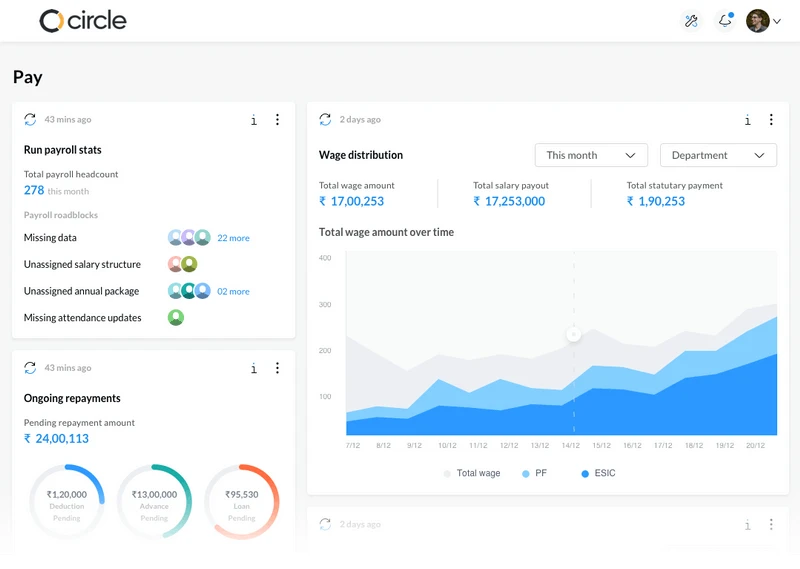Here is an interesting statistic: 70% of all employees do not like their work.
Employee engagement is arguably key to the success of any company’s goals. But it is extremely difficult to keep employees engaged at work. Disengagement means that the employees are not working towards being their best. They are working just enough to pay their bills and keep their job.
As an employer, how do you identify the engaged employees in your team?
Usually, engaged employees are enthusiastic and budding with new ideas for their company. You may think that if your employees are happy, they will engage in their work better. However, the truth is that even if employees like the work environment, they might not like doing their job, or at least not enough to exceed expectations.
But, if your work is getting done, why should you care for employee engagement?
In a recent study, it was found that companies that have a high rate of employee engagement are at least 21% more profitable. This means that companies literally lose millions because they do not pay attention to engagement.
Gallup’s State of the Global Workplace report shows that only 15% of the world’s employees are invested in the growth of their company – this clearly emphasizes how dire the consequences of disengaged employees can be.
Today, employees don’t just deserve (and demand) a comfortable working environment but they also expect clearly defined roles and goals. The lack of either or both shows a lack of employee engagement.
Finally, one of the top reasons why employees decide to leave their company is boredom. According to Quantum Workplace, 43% of workers are bored, and that is not a very promising metric.
This boils employee engagement down to two strategies:
- Through extra-curricular activities that help employees take their minds off work once in a while.
- By empowering them with a purpose (clear goals) and enabling them to see the impact they’re making.
While there are innumerable ways to achieve the ‘extra-curricular’ aspects of employee engagement, in this article we’re going to focus on a new-age system that can help you implement the other way – through OKRs.
What is OKR?
OKR stands for Objectives and Key Results. It’s a technique by which a company creates a set of objectives and also defines key results to measure the achievement of those objectives. The biggest companies in the world, such as Google use this strategy.
These OKRs start from the company level and then progress to the team level, and finally down to each employee. When there is a clear progression through this hierarchy, the strategy can perfectly align all employees to work towards a common company objective.
With OKRs in place, your employees will automatically realize that their effort and work is directly making an impact on the company. This system can express your goals and expectations clearly and paint a clear picture to your employees about where your company wants to go and how they can help. Once your employees understand what they are working towards, they will engage with the work more passionately.
An OKR strategy must include two things:
- Objective: The objective is the aim that you and your employees will be working towards. Once it is well-defined, you will need to assign initiatives which define the progress each employee has to make.
- Key results: Once the initiatives are concluded, the key results are observed. These key results will let you know how successful the initiatives were and what changes need to be made to get closer to the objective.
OKR does not ensure 100% success. It only ensures that every employee will be actively working towards a company goal. They can understand their impact on the company, which can be an appreciation boost for them.
Before getting into how you can implement such strategies for your company, let us look at the difference between OKRs and KPIs and who the early adopters of OKRs were.

What is the difference between OKR and KPI?
KPI is an acronym for key performance indicators. These indicators are mostly quantitative and are used by companies to evaluate their progress. Usually, KPIs can be classified as metrics and targets, as they are expressed in numbers. Also, KPIs are performance goals of the present, while OKRs represent future goals and the direction in which you want your company to move into. To make it clearer, here are some examples of OKRs and KPIs.
Examples of OKRs
Objective: Increase annual revenue by 40%
- Key Result 1 : Bring in 50 new customers through sales
- Key Result 2 : Expand services to 5 new locations
- Key Result 3 : Increase marketing staff by 10 %
Examples of KPIs
Key performance indicators are titles given to metrics that are numerical. Some Human Resources related performance indicators are:
- Rate of absenteeism
- Training costs
- Employee productivity
- Employee turnover rate
History of OKRs
Peter Drucker was the first person to explore modern management as its own concept. He came up with the strategy of “Management by Objectives”. He believed that managers often get caught up in an “activity trap”, where they are unable to spend time on business goals and company-level goals.
The second person to progress from Peter Drucker’s MBO was Intel’s CEO, Andy Grove. Grove upgraded the concept by adding in Key Results. It was a simple way to measure employee performance and move the organization into the correct direction.
The next person to transform this strategy was John Doerr, who was a part of the management team at Intel. Doerr was a Silicon Valley venture capitalist who became an advisor for Google. His theory of OKRs caught the attention of co-founders Larry Page and Sergey Brin. OKRs are now an integral part of how the company works. The co-founder’s credit this plan to a company-wide growth, boost in morale and several innovations. This is highlighted in the book “How Google Works”.
How can I start planning OKRs in my company?
No matter what business you run, OKR can be a refreshing strategy for you, as long as you primary goals is towards output management; Here is how you can implement this strategy in your company.
- Explain about OKRs to your entire team
Before you begin planning about OKR, get the entire company on the same page. Explain the process of OKR and the objective you are planning to achieve through it. Ask your employees if they are comfortable with the process and understand how to complete the tasks that will be assigned to them under OKR.
- Use a user-friendly OKR Software or tool
Once your employees are engaged in the method, you need a tool that can help you implement it. You can opt for a simple worksheet or get ready-made OKR software which can be configured to your needs.
An OKR software will clarify the actions to be taken and show everyone the progress being made towards the company’s goals on a single page. With the OKR software, you can also collect all your data in one place so that it can be easy to refer to in the future.
sumHR offers a great OKR Software, you can book a demo or try a free trial.
- Organize your info in a hierarchy
The main objective of setting up an OKR is bringing about a structural goal in your workflow. Sort your objectives in a pyramid-like structure that starts from the top and trickles down to the base.
The objectives are measured by several metrics, that is called the key results. Objectives at the top (from organization level) need to be ambitious, and not just quantifiable. The key-results need to be measurable, not the objective itself.
For example, if the objective is to achieve profitability by the end of the financial year, then the key-results can be reducing the cost by 25% and improving sales by 40%..
A quarterly or annual goal like this helps employees to prioritize their efforts and implement strategies to reach the top of the pyramid.
The idea is to go about goal setting in a streamlined approach so that everyone can understand their role in the achievement of this common goal and feel motivated towards achieving it.
- OKRs on an organizational level
Creating a company-level OKRs is often the very first step for an organization to implement the strategy. This means that companies need to communicate their annual goals to their employees in the form of objectives. Most often, annual objectives are broken down into quarterly OKRs for better execution.
Bear in mind to not assign goals in the form of tasks. Setting up OKRs is not about micromanaging your employees at every level; it’s about providing support and allowing the teams to figure out how to reach the top of the pyramid. Think quality over quantity.
- OKRs for the team
Team objectives are vital in reaching a company goal. This involves each employee in the process of setting objectives. So, you should set up meetings with your team and discuss the best initiative you can pick as the HR manager. The initiative taken at the team level should provide key results which are in line with the company objective.
- OKRs for individual
Once the team has strategized an OKR for themselves, each team member will have to be assigned a personal OKR, after a discussion with them. This will promote the feeling of inclusion among the employees.
Salesforce discovered that employees will work up to 4.6 times better than usual when they feel recognised and included. So, by making them truly a part of the larger picture, you will receive better results.
In addition to this, each person can decide what tasks they need to accomplish in order to reach their goal. They can formulate personal plans and draft strategies to reach them.
- Improvements and tweaks
Once the OKR strategy has been completed at each level, review it to make sure that all objectives align with one another. If not, the HR manager needs to tweak the OKR strategy at each level.
Ensure that the objectives are not mandated or forced. The biggest aim of OKR is to boost employee engagement. You can modify the strategy using OKR software so that it satisfies the views of the company as well as the employees.
- Evaluation
Once the key results have been achieved, the HR manager needs to track progress for each employee’s performance; Measure your success in terms of grades or percentages. A success rate of 65-70% towards an ambitious goal is considered to be a great accomplishment.
If you find that the success rate is 100%, then review your objective, as it must not have been ambitious enough for the team. If you find the key results rate to be lower than 50%, then do not consider it as a failure. Most of the time, it means that your objective was too high and needs to be evaluated.
Benefits of OKRs
There is a reason why the top companies of the world have been using the OKR strategy. Once implemented successfully, OKR can increase the productivity of the employees and actively engage them to work in favour of the company. Listed below are all the benefits of OKR.
- Streamline the team
With a seamlessly working OKR software, you can set aims for each team and individual while aligning their objectives. The teams will be working towards achieving company OKRs. Thus, OKR lets the company go forth as a single entity in the same direction.
- Autonomy
Apart from developing a sense of unity among all departments, OKR also provides autonomy to each employee. Every employee and team have their own goal setting methodology to follow. The responsibility towards reaching these goals is on the individual as well.
This means that you should not engage in micromanaging, That will lead your workers to end up with a to-do list or a series of tasks to follow instead of a clear strategy.
- Flexibility
Long term goals tend to be rigid. With OKR, you can go by a quarterly cycle or any other time period that suits your team. It provides the flexibility to change tactics after each quarter so that you can find a strategy that works best for your team.
- Employee engagement
When employees know the big picture towards which they are working, they will be more engaged in their work. Also, seeing that your job directly affects the performance of the whole company gives a sense of purpose to the employees, which will increase their productivity.
- Avoid distractions
Short-term goals that are straightforward and direct ensure that the company and the employees do not diverge from the aim. OKR can increase the focus of the team, ensuring that each goal is achieved within the time limit. It will increase the profitability of the company and each employee as well.
- Learn from your mistakes
The average score of success in OKR methodology is 60-80%. It is not an issue if your company did not reach this mark. You need to revise your objectives and key results to set something that is plausible to be achieved. OKR strategy gives you the freedom to customize it so that it suits you and your company’s needs.
How are top companies using OKR?
OKR strategy came into being in the 1970s. Since then, several companies have adopted it, and their success is a clear indication of the practicality and impact of the strategy.
Companies like Adobe, Twitter, Intel and Google have been employing the strategy to increase profitability while providing satisfaction to their employees.
How do they do it? These are some ways that they achieve perfect results through OKR:
- Clear objectives
Your objectives should be clear so that every employee can understand it. A clear aim ensures better clarity in initiatives and better key results. Clear objectives can also be achieved through performance reviews and regular check-ins with your team.
- Encourage
Your objective should encourage the team to work harder. That doesn’t mean that you should set an impossibly high aim that cannot be achieved in the set time limit. Set a goal that inspires the employees and makes them think outside the box.
- Transparency
Companies like Google keep their vision and aim public. So, it is no secret that their employees know the big picture too. This increases accountability while making them realize that each of their efforts amounts to the company’s success.
- Acceptance of failure
Over-challenging objectives or stretch goals and key results sometimes tend to be demotivating to the employees as they feel unattainable. Company goals tend to follow a top-down process through which they divide the objective company-wide. If the goal-setting framework is too narrow at the top, then the individual OKRs will eventually read like a task list rather than an ambitious goal.
Any objective with a cumulative score of less than 40% is considered below-average, but in OKR terms, that doesn’t necessarily mean a failure. OKRs are measurable, but the primary goal of setting up OKRs is to simplify and engage.
If your quarterly objectives fail, you should reevaluate them and assess issues in the workflow. Celebration of success along the way of achieving key results is important, but accepting of failure and reassessing your performance and objective is essential.
SME and start-ups face fierce competition in the market. They need to maximize their productivity and efficiency to stay ahead in the game. With the OKR strategy, they can boost their performance in the least time while providing work satisfaction to their employees. Pick the best OKR software for your company to define performance management metrics for building success strategies.
sumHR offers a seamless OKR software that is customizable as per the requirements of the SME or start-up. Get in touch with us now to implement a textbook-perfect OKR strategy.








